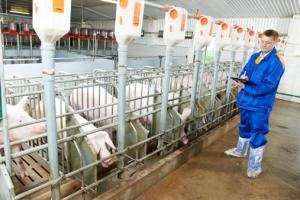Researchers today report identifying bacteria carrying a highly transmissible antibiotic-resistance gene in a US livestock operation, a finding that suggests a troubling new path for the spread of the drug-resistant pathogens.

In a study appearing in Antimicrobial Agents and Chemotherapy, investigators from The Ohio State University (OSU) say they recovered 18 isolates of multiple Enterobacteriaceaespecies harboring the beta-lactamase gene IMP-27, which confers resistance to carbapenem antibiotics, from the environment of an industrial US swine operation. All of the isolates carried the gene on what the researchers say is a highly mobile piece of DNA that can spread to a broad range of bacteria.
Carbapenems are a last line of defense against drug-resistant bacteria. While plasmid-mediated carbapenem-resistant Enterobacteriaceae (CRE) have been reported in European and Asian livestock and are known to cause life-threatening infections in US healthcare settings, this is the first time they have been identified in US livestock. The finding is surprising in part because carbapenem antibiotics are not approved for use in food animals in the United States.
Although the researchers say bacteria harboring the gene were not found in any of the pigs and are unlikely to have entered the food supply, the findings raise concerns about the possibility of foodborne transmission of CRE, which could expose consumers to the dangerous pathogens and have an impact on human health.
"That is the reason these results are so important," lead study author Thomas Wittum, PhD, chair of the department of veterinary preventive medicine at the OSU College of Veterinary Medicine, told CIDRAP News.
Isolates found in the barn environment
For the study, Wittum and his colleagues collected environmental and fecal samples from a 1,500-sow farrow-to-finish farm over the course of four visits in 2015, using sterile gauze sponges and electrostatic clothes to gather bacterial samples from the floors, crate floor covers, pen gates, and exhaust vent covers. Farrow-to-finish farms are typically confinement operations where pigs are bred and raised until they reach their slaughter weight.
Of the 30 samples collected from a nursery room on the team's initial visit, 2 of the samples yield three isolates. The three isolates—two Escherichia coli and one Proteus mirabilis—each carried the IMP-27 gene on IncQ1 plasmids.
On the third visit, the team collected environmental samples from the two farrowing rooms and identified 15 isolates from multiple Enterobacteriaceae species that carried the IMP-27 gene on IncQ1 plasmids. Each isolate expressed reduced susceptibility or resistance to meropenem, along with cephalosporins, sulfonamides, and tetracyclines.
No CRE was detected from samples taken on the fourth visit, which were all from harvest-ready pigs at the end of the production cycle.
Plasmids are small pieces of DNA that can be easily transmitted between different species of bacteria. Plasmid-mediated resistance is considered a greater health threat than chromosomally mediated resistance because it can spread more quickly and to many different types of bacteria. According to the study, IncQ plasmids have the broadest host range of any known replicating elements in bacteria and have been found in gram-negative and gram-positive bacteria.
No CRE was found on the pigs or in any of the pig fecal samples reported in this study, which Wittum says is probably due to the low sensitivity of the swabs. But he noted that the team has since recovered fecal isolates harboring the IMP-27 gene from the farm.
Link to cephalosporin use
Although it is not known how IMP-27 was introduced to the farm, Wittum said he believes the pigs and sows were colonized with the CRE, then shed it in their feces, which explains how it was spread into the barn environment.
But how would a carbapenem-resistance gene spread in an environment where there is no selection pressure from carbapenem antibiotics? Wittum and his colleagues suggest selection pressure could result from the use of ceftiofur, a cephalosporin antibiotic that is given prophylactically to all piglets within a day after birth and to all male pigs at castration. Environmental recovery of IMP-27-bearing isolates was highest in the farrowing barn (where the pigs are born), and lowest in the nursery and finishing barns, where the antibiotic is used only to treat sick pigs.
While the exact relationship between cephalosporin use and carbapenem resistance hasn't been established, Wittum said there is a "clear relationship between CRE and ceftiofur use in the farrowing barn at this farm." But whether there is such a relationship throughout the hog industry is unclear.
"That is one of the important scientific questions that need to be answered," Wittum said. "We're still working on that one."